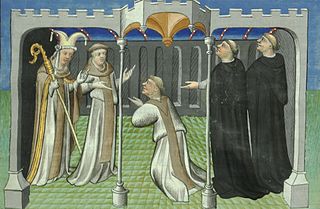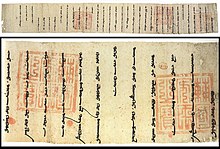
The Ilkhanate or Il-khanate, also known as the Ilkhanids, and known to the Mongols as Hülegü Ulus, was a Mongol khanate established from the southwestern sector of the Mongol Empire. The Ilkhanid realm was officially known as the Land of Iran or simply Iran. It was established after Hülegü, the son of Tolui and grandson of Genghis Khan, inherited the West Asian part of the Mongol Empire after his brother Möngke Khan died in 1259.

Abaqa Khan, was the second Mongol ruler (Ilkhan) of the Ilkhanate. The son of Hulagu Khan and Lady Yesünčin and the grandson of Tolui, he reigned from 1265 to 1282 and was succeeded by his brother Ahmed Tekuder. Much of Abaqa's reign was consumed with civil wars in the Mongol Empire, such as those between the Ilkhanate and the northern khanate of the Golden Horde. Abaqa also engaged in unsuccessful attempts at invading Syria under the Mamluk Sultanate, which included the Second Battle of Homs.

Rabban Bar Ṣawma, also known as Rabban Ṣawma or Rabban Çauma, was a Uyghur or Ongud monk turned diplomat of the "Nestorian" Church of the East in China. He is known for embarking on a pilgrimage from Yuan China to Jerusalem with one of his students, Rabban Markos. Due to military unrest along the way, they never reached their destination, but instead spent many years in Ilkhanate-controlled Baghdad.

Arghun Khan was the fourth ruler of the Mongol empire's Ilkhanate, from 1284 to 1291. He was the son of Abaqa Khan, and like his father, was a devout Buddhist. He was known for sending several embassies to Europe in an unsuccessful attempt to form a Franco-Mongol alliance against the Muslim Mamluks in the Holy Land. It was also Arghun who requested a new bride from his great-uncle Kublai Khan. The mission to escort the young Kököchin across Asia to Arghun was reportedly taken by Marco Polo. Arghun died before Kököchin arrived, so she instead married Arghun's son, Ghazan.

Mahmud Ghazan was the seventh ruler of the Mongol Empire's Ilkhanate division in modern-day Iran from 1295 to 1304. He was the son of Arghun, grandson of Abaqa Khan and great-grandson of Hulegu Khan, continuing a long line of rulers who were direct descendants of Genghis Khan. Considered the most prominent of the il khans, he is perhaps best known for converting to Islam and meeting Imam Ibn Taymiyya in 1295 when he took the throne, marking a turning point for the dominant religion of the Mongols in West Asia: Iran, Iraq, Anatolia, and the South Caucasus.
Mulay, Mûlay, Bulay was a general under the Mongol Ilkhanate ruler Ghazan at the end of the 13th century. Mulay was part of the 1299–1300 Mongol offensive in Syria and Palestine, and remained with a small force to occupy the land after the departure of Ghazan. He also participated in the last Mongol offensive in the Levant in 1303. His name has caused confusion for some historians, because of its similarity with that of the contemporary Grand Master of the Knights Templar, Jacques de Molay.

Starting in the 1240s, the Mongols made repeated invasions of Syria or attempts thereof. Most failed, but they did have some success in 1260 and 1300, capturing Aleppo and Damascus and destroying the Ayyubid dynasty. The Mongols were forced to retreat within months each time by other forces in the area, primarily the Egyptian Mamluks. The post-1260 conflict has been described as the Mamluk–Ilkhanid War.

Öljaitü, also known as Mohammad-e Khodabande, was the eighth Ilkhanid dynasty ruler from 1304 to 1316 in Tabriz, Iran. His name means 'blessed' in the Mongolian language.

Several attempts at a Franco-Mongol alliance against the Islamic caliphates, their common enemy, were made by various leaders among the Frankish Crusaders and the Mongol Empire in the 13th century. Such an alliance might have seemed an obvious choice: the Mongols were already sympathetic to Christianity, given the presence of many influential Nestorian Christians in the Mongol court. The Franks—Western Europeans, and those in the Levantine Crusader states—were open to the idea of support from the East, in part owing to the long-running legend of the mythical Prester John, an Eastern king in an Eastern kingdom who many believed would one day come to the assistance of the Crusaders in the Holy Land. The Franks and Mongols also shared a common enemy in the Muslims. However, despite many messages, gifts, and emissaries over the course of several decades, the often-proposed alliance never came to fruition.

In modern times the Mongols are primarily Tibetan Buddhists, but in previous eras, especially during the time of the Mongol empire, they were primarily shamanist, and had a substantial minority of Christians, many of whom were in positions of considerable power. Overall, Mongols were highly tolerant of most religions, and typically sponsored several at the same time. Many Mongols had been proselytized by the Church of the East since about the seventh century, and some tribes' primary religion was Christian. In the time of Genghis Khan, his sons took Christian wives of the Keraites, and under the rule of Genghis Khan's grandson, Möngke Khan, the primary religious influence was Christian.
Isol the Pisan, also known as Ciolo Bofeti di Anastasio or Zolus Bofeti de Anestasio, was an Italian merchant, diplomat, and military leader. For some time he resided at the court of the Mongol Ilkhan, Ghazan, in Persia, rising to become his ambassador or liaison to the Kingdom of Cyprus. His high status at Ghazan's court may stem from his being the godfather of Öljeitü at the latter's baptism.

Buluqhan Khatun, also Bulughan, Bulukhan, Bolgana, Bulugan, Zibeline or Bolghara for Marco Polo, was a 13th-century Mongol princess, and the principal wife of the Mongol Ilkhanid ruler Abaqa (1234–1282).
Tommaso Ugi di Siena was a 14th-century Italian adventurer, native of the city of Siena in Italy. He resided at the court of the Mongol Ilkhanid ruler Oljeitu in the Persian capital of Tabriz, where he held the high position of Ildüchi, "Sword bearer", for Oljeitu. Other adventurers, such as Buscarello de Ghizolfi or Isol the Pisan, are known to have played similar roles at the Mongol court. Hundreds such Western adventurers entered into the service of Mongol rulers.
Nawrūz was a son of governor Arghun Aqa, and was a powerful Oirat emir of the 13th century who played an important role in the politics of the Mongol Ilkhanate.
Kutlushah, Kutlusha or Qutlughshah, was a general under the Mongol Ilkhanate ruler Ghazan at the end the 13th century. He was particularly active in the Christian country of Georgia and especially during the Mongol invasion of Syria, until his ignominious defeat in 1303 led to his banishment. He was killed during the conquest of Gilan in 1307.

A Byzantine-Mongol Alliance occurred during the end of the 13th and the beginning of the 14th century between the Byzantine Empire and the Mongol Empire. Byzantium attempted to maintain friendly relations with both the Golden Horde and the Ilkhanate realms, who were often at war with each other. The alliance involved numerous exchanges of presents, military collaboration and marital links, but dissolved in the middle of the 14th century.

The fall of Ruad in 1302 was one of the culminating events of the Crusades in the Eastern Mediterranean. In 1291, the Crusaders had lost their main power base at the coastal city of Acre, and the Muslim Mamluks had been systematically destroying the remaining Crusader ports and fortresses in the region, forcing the Crusaders to relocate the dwindling Kingdom of Jerusalem to the island of Cyprus. In 1299–1300, the Cypriots sought to retake the Syrian port city of Tortosa, by setting up a staging area on Ruad, two miles (3 km) off the coast of Tortosa. The plans were to coordinate an offensive between the forces of the Crusaders, and those of the Ilkhanate. However, though the Crusaders successfully established a bridgehead on the island, the Mongols did not arrive, and the Crusaders were forced to withdraw the bulk of their forces to Cyprus. The Knights Templar set up a permanent garrison on the island in 1300, but the Mamluks besieged and captured Ruad in 1302. With the loss of the island, the Crusaders lost their last foothold in the Holy Land and it marked the end of crusader presence in the Levant region.

Yahballaha III, known in earlier years as Rabban Marcos was Patriarch of the East from 1281 to 1317. As patriarch, Yahballaha headed the Church of the East during the severe persecutions under the reign of khans Ghazan and his successor Öljaitü. He acknowledged the primacy of the Pope and tried to form a church union, which was rejected by the Nestorian bishops of the Church of the East.

Mongol Armenia or Ilkhanid Armenia refers to the period beginning in the early-to-mid 13th century during which both Zakarid Armenia and the Armenian Kingdom of Cilicia became tributary and vassal to the Mongol Empire and the successor Ilkhanate. Armenia and Cilicia remained under Mongol influence until around 1335.

The fall of Outremer describes the history of the Kingdom of Jerusalem from the end of the last European Crusade to the Holy Land in 1272 until the final loss in 1302. The kingdom was the center of Outremer—the four Crusader states—formed after the First Crusade in 1099 and reached its peak in 1187. The loss of Jerusalem in that year began the century-long decline. The years 1272–1302 are fraught with many conflicts throughout the Levant as well as the Mediterranean and Western European regions, and many Crusades were proposed to free the Holy Land from Mamluk control. The major players fighting the Muslims included the kings of England and France, the kingdoms of Cyprus and Sicily, the three Military Orders and Mongol Ilkhanate. Traditionally, the end of Western European presence in the Holy Land is identified as their defeat at the Siege of Acre in 1291, but the Christian forces managed to hold on to the small island fortress of Ruad until 1302.

















